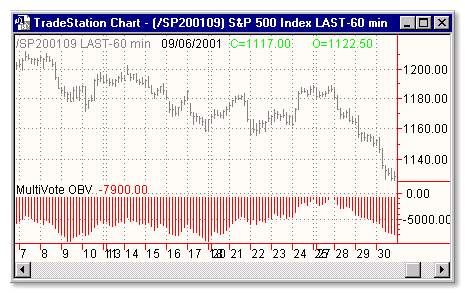Download: multobv.ELA
File Includes: Indicator - MultiVote OBV
Category: Indicator > Miscellaneous
Description:
Many indicators try to divine from daily data what went on in intraday trading. For example, the simple on-balance volume indicator (OBV) assigns the full impact of a day's full volume by the behavior of the closes. For steady-volume blue chips, this is not much of a problem, but it is for thinly traded stocks such as the penny stocks. The close could be affected by a small last-minute trade in a very thin market. Traders of penny stocks will have noticed an adverse sensitivity of the classic unmodified on-balance volume indicator (OBV).
The author incorporated the high and the low in the calculation of the OBV indicator and called that indicator "the multivote OBV".
Usage:
Price represents the consensus of value, while volume represents the emotions of traders/investors. Volume tracks the intensity of the financial and emotional commitment of traders. Since OBV is a running total of Volume its a great way to track the changes in traders involvement in a stock. When OBV reaches a new high it shows the bulls are strong, the bears are in pain and prices are likely to rise. Vice-versa if OBV reaches a new low. OBV is a "leading indicator" meaning it usually precedes changes in price. When the pattern of OBV deviates from the pattern of prices, it shows that mass emotions are not in gear with mass consensus. A crowd is more likely to follow its heart than its mind. This is the main reason changes in volume often precede changes in price.

No Inputs
EasyLanguage Code:
VARS: HIGHVOTE(0), LOWVOTE(0), CLOSEVOTE(0), TOTALVOTE(0), MYOBV(0);
HIGHVOTE = 0;
LOWVOTE = 0;
CLOSEVOTE = 0;
IF HIGH > HIGH[1] THEN HIGHVOTE = 1 ELSE
IF HIGH < HIGH[1] THEN HIGHVOTE = -1;
IF LOW > LOW[1] THEN LOWVOTE = 1 ELSE
IF LOW < LOW[1] THEN LOWVOTE = -1;
IF CLOSE > CLOSE[1] THEN CLOSEVOTE = 1 ELSE
IF CLOSE < CLOSE[1] THEN CLOSEVOTE = -1;
TOTALVOTE = HIGHVOTE + LOWVOTE + CLOSEVOTE;
MYOBV = MYOBV[1] + ( VOLUME * TOTALVOTE );
PLOT1( MYOBV, "MULTOBV");